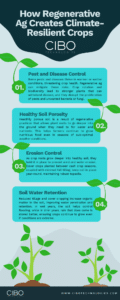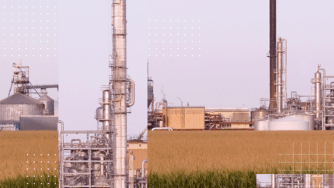
Regenerative agriculture (RA) is a more holistic approach to farming that emphasizes soil health, biodiversity, and ecosystem function. This approach is known to create climate-resilient crops and secure our food systems in several ways:
- Building soil health: RA practices such as cover cropping, crop rotation, and reduced tillage help to build soil health by increasing soil organic matter, enhancing soil structure, and improving soil water retention. This creates a more resilient soil ecosystem which in turn supports healthy plant growth, better nutrient uptake and increased plant resistance to pests and diseases.
- Enhancing biodiversity: RA practices such as intercropping, agroforestry, and the use of native plant species help to promote biodiversity on farms. This increased biodiversity supports the growth of a wider range of crops and helps to mitigate the impact of climate change by providing natural pest control, reducing soil erosion, and increasing carbon sequestration.
- Sequestering carbon: RA practices such as cover cropping, reduced tillage, and the use of compost and other organic fertilizers, as well as carbon fixing biologicals, can help to sequester carbon in the soil. This can help to mitigate climate change by reducing greenhouse gas emissions and increasing carbon storage in the soil.
- Increasing resilience to climate change: By building soil health, enhancing biodiversity and sequestering carbon, RA helps to create a more resilient farming system that can better withstand the impacts of climate change. This includes more extreme weather events such as droughts and floods, as well as the spread of pests and diseases.
Overall, RA is a powerful tool for creating climate-resilient crops and security of our food system. By focusing on soil health, biodiversity, and an ecosystem function perspective, RA can help to mitigate the impact of climate change, increase the resilience of our food system and support healthy and sustainable agriculture for generations.
Download the Infographic



